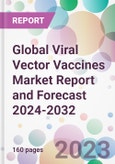The global viral vector vaccines market size was valued at USD 820.0 million in 2023, driven by the rapid advances in vaccine technology and the ongoing development of vaccines against infectious diseases and cancers. The market size is anticipated to grow at a CAGR of 19.6% during the forecast period of 2024-2032 to achieve a value of USD 4,098.9 million by 2032.
North America and Europe are major players in the global viral vector vaccines market due to their advanced healthcare infrastructure, robust research and development capabilities, and substantial investment in vaccine development. Emerging markets in Asia Pacific and Latin America are showing significant growth potential, driven by increasing healthcare awareness and infrastructure development.
Viral Vector Vaccines: Introduction
Viral vector vaccines represent an innovative approach to vaccination that has gained significant attention, especially in the context of emerging infectious diseases and the ongoing global efforts to combat various pathogens. These vaccines use a harmless virus, known as a viral vector, as a delivery system to introduce genetic material from a target pathogen into the human body. This genetic material stimulates the immune system to produce a protective response against the target pathogen.Significance of Viral Vector Vaccines:
Viral vector vaccines are significant because they offer a versatile and effective platform for developing vaccines against a wide range of infectious diseases, including viral infections and certain cancers. They are particularly valuable in situations where traditional vaccine development methods may face challenges.Key Trends in the Global Viral Vector Vaccines Market
- Expanding Vaccine Development Platforms: Researchers are exploring a variety of viral vectors, including adenoviruses, vesicular stomatitis viruses (VSVs), and adeno-associated viruses (AAVs), for vaccine development. This diversity allows for targeting a wide range of diseases, including infectious diseases and certain cancers.
- COVID-19 Vaccine Development and Beyond: The COVID-19 pandemic has accelerated the development and adoption of viral vector vaccines. The success of COVID-19 vaccines using viral vectors has sparked interest in applying this technology to other infectious diseases, such as HIV and influenza.
- Cancer Vaccines: Viral vector vaccines are being investigated as a tool in cancer immunotherapy. They can deliver tumor-specific antigens or genetic material to trigger an immune response against cancer cells. The market for cancer vaccines is expected to grow as more research and clinical trials take place.
- Gene Therapies: Viral vectors are not limited to vaccines; they are also essential in gene therapy applications. As gene therapy becomes more common in treating genetic disorders, viral vectors are playing a crucial role in delivering therapeutic genes.
Global Viral Vector Vaccines Market Segmentations
The market can be categorised into type, application, disease, end user and region.Market Breakup by Type
- Adenovirus
- Retrovirus
- Plasmid DNA
- AAV
- Lentivirus
- Others
Market Breakup by Application
- Antisense and RNAi
- Gene Therapy
- Cell Therapy
- Vaccinology
Market Breakup by Disease
- Cancer
- Genetic Disorders
- Infectious Diseases
- Others
Market Breakup by End User
- Pharmaceutical
- Biopharmaceutical Companies
- Research Institute
Market Breakup by Region
- North America
- Europe
- Asia Pacific
- Latin America
- Middle East and Africa
Global Viral Vector Vaccines Market Overview
The global viral vector vaccines market is a rapidly growing segment within the broader vaccine industry. Viral vector vaccines use harmless viruses as vehicles, or vectors, to deliver genetic material from a target pathogen into the human body. This genetic material stimulates an immune response and triggers the production of antibodies and immune memory cells, providing protection against specific diseases. The global viral vector vaccines market has witnessed substantial growth in recent years, and this trend is expected to continue. Factors contributing to market growth include advances in vaccine technology, increasing investment in research and development, and the urgent need for vaccines against emerging infectious diseases.North America and Europe are major players in the global viral vector vaccines market due to their advanced healthcare infrastructure, robust research and development capabilities, and substantial investment in vaccine development. Emerging markets in Asia Pacific and Latin America are showing significant growth potential, driven by increasing healthcare awareness and infrastructure development.
Key Players in the Global Viral Vector Vaccines Market
The key features of the market report include patent analysis, grants analysis, clinical trials analysis, funding and investment analysis, partnerships, and collaborations analysis by the leading key players.The major companies in global viral vector vaccines market are as follows:
- Novasep
- Merck KGaA
- Charles River Laboratories
- uniQure N.V
- Waisman Biomanufacturing
- Creative-Biogene
- Aldevron
- Addgene
- Oxford Biomedical
- Thermo Fisher Scientific Inc
Table of Contents
1 Preface
3 Global Viral Vector Vaccines Market Overview
4 Global Viral Vector Vaccines Market Landscape
5 Global Viral Vector Vaccines Market Dynamics
6 Global Viral Vector Vaccines Market Segmentation
7 North America Viral Vector Vaccines Market
8 Europe Viral Vector Vaccines Market
9 Asia Pacific Viral Vector Vaccines Market
10 Latin America Viral Vector Vaccines Market
11 Middle East and Africa Viral Vector Vaccines Market
12 Regulatory Framework
13 Patent Analysis
14 Grants Analysis
15 Clinical Trials Analysis
16 Funding and Investment Analysis
17 Partnership and Collaborations Analysis
18 Supplier Landscape
20 Company Competitiveness Analysis (Additional Insight)
21 Payment Methods (Additional Insight)
Companies Mentioned
- Novasep Merck KGaA
- Charles River Laboratories
- uniQure N.V
- Waisman Biomanufacturing
- Creative-Biogene
- Aldevron
- Addgene
- Oxford Biomedical
- Thermo Fisher Scientific Inc
Methodology

LOADING...








